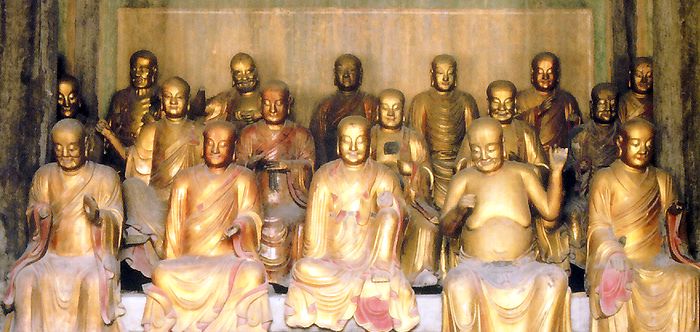
|
Go to
Jordan's main page
China Resources main page, Chinese Tales index page |
Content Created: 110104 |

Definition. Technically, an arhat or luóhàn 罗汉 is a Buddhist adept who has attained a state where reincarnation will no longer be necessary, and nirvana lies just ahead. All disciples of the Buddha are assumed to have become arhats. In popular thought, arhats often have supernatural powers.
Statues. Most Chinese Buddhist temples include statues the arhats. Although many hundreds may sometimes be represented, a set of eighteen are found almost always. The list usually includes standard figures in a standard order, although there are occasional exceptions, where other figures are substituted for some of the "standard" eighteen.

Names. Sixteen of the "standard" set are Indians, with names that often have different Sanskrit and Pali forms and more than one transliteration into Chinese. Although a statue may often be identified by an Indian name (transliterated into Chinese characters), all of them also have Chinese titles that most people find more comfortable. For example, most Chinese find it easier to call the first figure in the series "The Arhat Who Rides a Deer" (Qílù Luóhàn 骑鹿罗汉) rather than using the cumbersome Chinese transliteration of his Indian name, "Arhat Pindola-bharadvaja" (Bīndùluó-báluō-duòdū zūnzhě 宾度罗跋啰惰阇尊者).
Stories. In my experience, relatively few people in China can actually recount stories about particular luóhàn, and indeed most people can't name more than one or two at most. But everyone recognizes them in their collectivity, and they are assumed to have stories —perhaps miraculous ones— even if the stories are not commonly told. The following list contains links to such stories as I have found for each arhat, plus his alternative Chinese names and Chinese transliterations of his Indian name(s).
Titles. Any of these names may have the expression zūnzhě 尊者 ("senior monk") or luóhàn 罗汉 (or āluóhàn 阿罗汉) ("arhat") suffixed as a term of respect. Zūnzhě is slightly more formal and is usually found after transliterated Indian names. Luóhàn is more usual after the shorter Chinese colloquial names or titles. In this list, zūnzhě has been omitted from the already long Indian names to simplify the listing, but luóhàn has been retained in the colloquial Chinese names because I have never heard the Chinese names used without a title.
The listing retains the traditional "arhat numbers," with additional people, not usually included in the eighteen, listed at the end.
The following figures are sometimes included among the 18 arhats in place of some of those in the list above, but it seems safe to say that they are not part of the "standard" set. In most cases their stories are not included here.
The following titles are occasionally given when referring to figures among the 18 arhats, but I have not yet been able to establish with certainty whether any are consistently enough applied to be reliable identifications.
This page has been viewed
times since 101230.